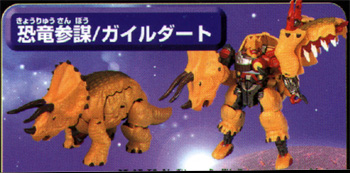 BEAST WARS: TOY
REVIEW
BEAST WARS: TOY
REVIEW
Guildart also has a third, ‘battle-damage’ mode, which is a variation on his beast mode. Pull out his tail slightly, exposing the red flesh, then open one of the flaps on his flank to expose ribs and more flesh. Push back on his nose horn, his tongue protrudes further, and his eyes roll back! This can be used as a decoy mode, to fool his enemies into believing he is wounded, so he can ambush them.
For a toy with a relatively complex transformation, there is surprisingly little robot kibble visible in this mode. Part of the robot arm can bee seen on its chest, and parts of the robot legs can be seen from behind and underneath, but not enough to disrupt the overall appearance of the beast.
The beast mode head forms his right arm, with the crest forming a formidable shield, and the horns enhancing to this. The beast mode back forms a large shoulder shield (or ‘pauldron’) over his left shoulder, with sharp ribs and red flesh hanging downward, and the beast-mode front legs forming positionable guns; this further adds to his appearance of ferocity and hand-to-hand battle-readiness.
The robot head keeps many features of the triceratops head, and has a pronounced bulldog-scowl. A visual effect use nicely on this toy is the ragged flesh that appears in the transition from organic to robot parts; you can see this effect on the robot mode feet, launcher and pauldron. The organic and primitive elements of his armour are well used over the technological elements; he has what appears to be a leather baldrick across his chest, and a gauntlet with a stabbing weapon on his left hand. The pebbled skin of the triceratops mode forms impressive knee-pads (or ‘poleyns’), as well as the remainder of his body armour. He has 17 points of articulation in this mode, including his armour.
This is a fine robot; I would actually have prepared to buy this as a robot action figure even if it didn’t transform!
Triceratops had a single, short nasal horn and horns as long as hockey sticks protruding above its eyes. Its head, sometimes as much as three metres long, was the largest ever possessed by a land animal. It had large eyes and a relatively large brain.
Triceratops was probably a feisty animal. Many specimens have bones damaged in combats with rivals or predators.
Triceratops remains were first discovered near Denver, Colorado (USA), in 1887. At first they were identified as the remains of a recently extinct species of buffalo.
Bibliography: Royal
Tyrrell Musuem